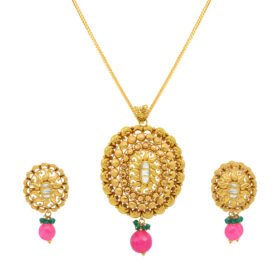
Gold jewelry has adorned human beings for thousands of years, transcending cultures and civilizations. Its allure is universal, and its history is rich and fascinating. Let’s take a journey through time and explore the captivating history of gold jewelry.
Ancient Beginnings
The story of gold jewelry begins over 6,000 years ago in ancient Mesopotamia, where artisans first discovered the art of working with this precious metal. These early jewelers crafted intricate pieces using simple tools, setting the stage for the evolution of gold jewelry.
Egyptian Extravagance
One of the most iconic periods in the history of gold jewelry is Ancient Egypt. Pharaohs and queens adorned themselves with exquisite gold ornaments. The symbolism was significant: gold represented the sun, eternity, and divinity. The burial sites of Egyptian royalty reveal astonishing treasures, including intricate gold necklaces, bracelets, and headpieces.
Greek and Roman Influence
The Greeks and Romans embraced the art of gold jewelry, infusing their own styles and symbolism. Greek jewelry often featured mythological motifs, while Roman designs included intricate filigree work and gemstone settings. Gold jewelry became a symbol of status and sophistication in these ancient civilizations.
Medieval Mastery
During the Middle Ages, goldsmiths refined their craft further. Gothic jewelry, characterized by its intricate designs and religious themes, gained popularity. Goldsmiths also started incorporating gemstones, such as sapphires and rubies, into their creations, adding depth and color to their pieces.
The Renaissance Revival
The Renaissance marked a resurgence in the appreciation of classical art and culture. Gold jewelry of this era reflected this renaissance spirit, featuring intricate engravings, cameos, and a revival of ancient motifs. This period laid the foundation for the modern fascination with antique gold jewelry.
Colonial Conquests
The Age of Exploration brought an influx of gold from the New World to Europe. This newfound abundance of gold allowed jewelers to experiment with larger, more opulent designs. The Baroque period, known for its elaborate and ornate jewelry, was a product of this era.
Victorian Virtuosity
The Victorian era was characterized by its sentimentality, and this was reflected in jewelry. Queen Victoria’s love for her husband, Prince Albert, inspired a trend of sentimental jewelry, often featuring lockets, cameos, and pieces incorporating hair. The Victorian era also saw the popularity of mourning jewelry, crafted from black and gold.
The Roaring Twenties and Beyond
The 20th century brought about significant changes in fashion and jewelry. The Art Deco movement, characterized by geometric shapes and bold designs, swept the world. Gold remained a popular choice, but platinum gained prominence due to its durability.
Modern Marvels
In the modern era, gold jewelry has continued to evolve. From minimalist designs to bold statement pieces, there’s a style for every taste. White and rose gold, created by alloying gold with other metals, have expanded the options available to jewelry lovers.
Conclusion
The history of gold jewelry is a tapestry woven with craftsmanship, culture, and creativity. Across centuries and continents, gold jewelry has been more than just adornment; it’s been a reflection of society, spirituality, and individual expression. Today, this enduring metal continues to captivate us, offering a timeless connection to our shared human history.
In a world of ever-changing fashion trends, gold jewelry remains a symbol of enduring elegance and a testament to the craftsmanship of artisans throughout the ages. Whether you’re wearing a family heirloom or a modern creation, the allure of gold jewelry is, and always will be, timeless.
